LATIN ESSENTIALS
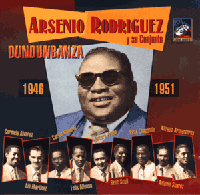
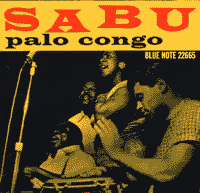
ARSENIO RODRIGUEZ Y SU CONJUNTO
DUNDUNBANZA 1946-51 (Tumbao TCD041)
Arsenio was blinded as a lad of 8 when a horse kicked him in the head. He took up the tres at age 15, a six-string guitar that has three pairs of sympathetic strings. He wrote many songs, often reaching into his Congolese heritage for lyrics or ideas. When a doctor told him he would never see again, he dictated the lyrics of "La Vida es un sueño (Life is but a dream)" to his brother. He gigged around until 1940 when he founded his own group. To the traditional sextet line-up he added a second trumpet, piano and conga drum, a revolutionary innovation that changed the form of Cuban music and has remained the basic conjunto line-up since. They added a jamming outro to the son, which then became the son-montuno. In 1951 Arsenio moved to New York, but fame and fortune eluded him. He left behind a stellar band whose rhythm section regrouped as Conjunto Modelo.
Arsenio does show up on an incredible Blue Note album, PALO CONGO by Sabu (Blue Note 22665), that is now back in print as a budget CD (It flopped on its original release as Blue Note jazz fans didn't know what to make of it, and it was cut-out. Ten years ago collectors were paying up to $300 for a copy!).
Arsenio's compositions have gradually become standards and many of his original 78 rpm recordings have been tracked down and reissued on CDs of varying sonic quality. The Tumbao reissues contain the cream of his Cuban recordings, DUNDUNBANZA includes several of his most popular songs, including the title cut (from a Congolese original), "No me llores mas," "Vuelvo a la vida," and "Los Sitios Hacere." The band includes Felix Chappotin and Chocolate Armenteros on trumpets, Lili Martinez on piano, Papa Kila on bongos, and René Scull on vocals. Chappotin did go on to solo fame as a bandleader, and Lili Martinez had a huge influence on the generation that followed him, but Arsenio remains a true giant of Cuban music.
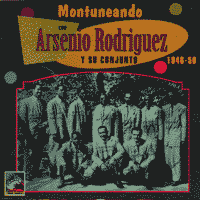
ARSENIO RODRIGUEZ Y SON CONJUNTO
MONTUNEANDO 1946-50 (Tumbao TCD 031)
Here's a desert island disc that hits the ground running and doesn't let up. Arsenio had the hardest-driving rhythm section in Cuban music and his sound was so influential it finally broke into salsa as we know it today. The basswork of Lazaro Prieto, and the piano of Lili Martinez are the perfect cushion. Added to that the skin-whopping talents of Papa Kila on bongos and Felix Alfonso on bongo and you have a restless energy that chugs ever forward. Along with DUNDUNBANZA you hear the best of Arsenio's early recordings on MONTUNEANDO. The album opens with "Dame un cachito pa huele" and "Chicharronero" back to back, two short but smoking jams. Then a touch of classical piano introduces the coro and horns for a restrained opening to "Semilla de cana brava." After trumpet solos, Arsenio comes in for a brief but elegant solo and the outro features the horns playing against one another, reuniting for the last chords. These three son-montunos are followed by a guaguanco, "Juventud Amaliana," that is so accomplished and self-assured in its delivery, one presumes they played it a hundred times in concert before recording it. The hits keep coming with "El Reloj de Pastora" which has been covered notably by Orchestre Sierra Maestra. The album ends with the rave-up tribute to the rhythm section "Kila, Quique y Chocolate."
In the forties most of the talented musicians in Havana passed through Arsenio's band, though he kept his core intact, including his cousin René Scull on vocals. In the early fifties Arsenio visited New York to consult an eye specialist and recorded a few jams with Chano Pozo and Machito (collected on LEGENDARY SESSIONS [TCD 017]). By the mid-fifties he moved to New York and started a new conjunto though never again would have the success he had enjoyed in Havana. Despite his importance in the music he died obscure and impoverished in Los Angeles, December 30, 1970, aged 59.
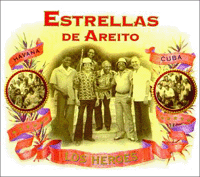
ESTRELLAS DE AREITO
LOS HEROES (World Circuit 1998 WCD052)
For two weeks LOS HEROES by Estrellas de Areito has been stuck in my CD player. This truly legendary group was assembled for a project in the late '70s by a West African producer visiting Havana, and included a "Who's Who" of Latin talent, including artists like trombonist Juan Pablo Torres, Pio Leyva, and other vocalists Rolo Martinez, Migelito Cuni, and Carlos Embale, Adalberto Lara and Chapottin the trumpet-players, Enrique Jorrin, inventor of the cha cha rhythm, and pianist Ruben Gonzalez (who was "rediscovered" by Ry Cooder). Their sessions were only ever available in Cuba on truncated cassettes and appeared briefly in Europe on vinyl. There was a Japanese box set on CD, but it was costly and was taken straight off the albums. Now World Circuit has done it right with their typical smart packaging, informative booklet, and crisply remastered sound.
The second CD in the two-CD set, beginning with the swinging jam, "Guaguanco a todos los Barrios" is my favorite reissue of the year 1998. Each song is a ten-minute-plus descarga where anything goes, and they all surpass one another constantly. This set will stand for a long time as the definition of the term "descarga" -- which actually means "flush," but these songs are flushed with pride.
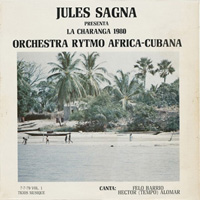
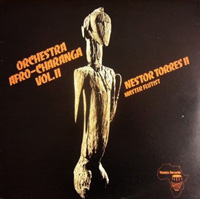
ORCHESTRA RYTMO AFRICA-CUBANA
JULES SAGNA PRESENTA LA CHARANGA 1980 (7779 vol 1)
ORCHESTRA AFRO-CHARANGA VOL II (Thiokis Records JS21480)
This is one of the oddest two-record sets in music, mainly because the personnel and even the name of the band changes, yet there are indications that there is intended continuity here. Since there are no liner notes I will add some conjecture. The producer Jules Sagna is, I believe, Senegalese. Like many West Africans he was enamored of salsa music and so hired the Latin Sounds studio on Broadway in New York and assembled some top notch session musicians to cut some standards and original tunes. This had been done earlier by Aboudou Lassissi with great success and those Sacodis releases of African soneros fronting Neuva Yorquino salseros were all the rage from Abidjan to Dakar. (And continued to draw followers when Sylla cottoned onto the idea with his later popular grouping Africando.) For Sagna's first effort he hired Alfredo de la Fé, the violinist, and had him assemble a charanga group, including Sonny Bravo on piano, Nestor Torres on flute, Charlie Rodriguez on tres, Nicky Marrero, star timbalero of Fania records, and Felo Barrio and Hector Alomar as vocalists. The impromptu grouping was dubbed Orchestra (note American spelling) Rytmo Africa-Cubana (although there were no Africans present, other than Sagna, they did a song titled "Vamos pa Dakar"). The catalog number 7-7-79 leads me to suspect that was the recording date, and the LP was released in 1980 as La Charanga 1980 Volume 1, and reissued on CD in 1992. Right from the start it explodes with some crazy violin soloing on "Galletana" that is run through a space echo so Alfredo sounds like he is a whole string section as Nestor chases him on flute. It does not let up.
Later that year a second volume appeared with different musicians and a different band name. This was Orchestra Afro-Charanga Vol. II. Nestor Torres the flautist has taken the helm and again it's a mix of public domain and original tracks, with familiar jams on "El Manicero" and other chestnuts inevitably creeping in. Despite the change in personnel the producer is Jules Sagna and once again the session is held at Latin Sound NYC. And again there is an African twist on the track "Sénégal en Africa." The reason I am dwelling on this is that both albums are the quintessential Latin jam session. Of course each stands alone, volume two perhaps having the edge in intensity. There is also violin on the second, played by Eddie Drennon less vociferously than Alfredo, and Nestor's dad has taken over the ivories. Bass is plucked by Andy Gonzalez, Charlie Rodriguez returns on tres, and there's no shortage of luminaries on the other instruments: Orestes Vilato on timbales, Angel Maldonado on conga, and Papo Vasquez on trombone. Hector Alomar returns on vocals and is joined by Vicente Consuegra. This is essential and shows skilled musicians improvising at the top of their game with superb performances all round.
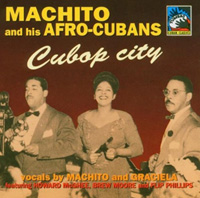
MACHITO AND HIS AFRO-CUBANS
CUBOP CITY (Tumbao TCD-012)
Throughout the 1990s the Spanish label Tumbao Cuban Classics set out to publish a history of Cuban music on CD. Their budget sampler (out of print in US but available in Europe) called The Essence of Cuban Music skimmed fleetingly over the surface of this deep well, but did include a full-color 70-page book itemizing their whole collection. The discs were well-researched and compiled from good source material and included excellent liner notes and photos. The pinnacle of their efforts was a pile of box sets of Chano Pozo, Beny More and Arsenio Rodriguez and the complete recordings of Sexteto y Septeto Habanero. But more than just mouldy oldies repackaged, the series was full of revelations and was also educational, if you will pardon the expression. Like Dizzy Gillespie, Machito was eager to incorporate American jazz with Cuban rhythms (though he was coming at it from the opposite direction to Diz) so he brought Zoot Sims and Brew Moore (a Lester Young acolyte who features on "Vacilando" here) to his group on tenor saxes while Howard McGhee jammed alongside his bandleader Mario Bauza on trumpet, and featured on a bizzy cu-bop solo, "Howard's Blues." Having come to New York in 1937, Machito was a popular singer for many expatriate Cuban bands. His ideal would be a band that had elements of Duke Ellington, Glenn Miller, Count Basie and Chick Webb. From them he learned to respect musical traditions but also was eager to foreground the Afro-Cuban percussion. After his discharge from the US Army he was ready to bring Be-bop to his Afro-Cubans, one of the top bands in New York in the 40s. They were so popular the tide had turned and now American bandleaders like Stan Kenton were drawing inspiration from them. Dizzy had known Mario Bauza from Cab Calloway's orchestra and through him met conguero Chano Pozo who was central to his "Afro-Cuban Suite." Fortunately there are many recordings preserving the sound of Machito's band: he even had Charlie Parker in on one session. But I am partial to this radio transcription because it captures the excitement of the band in concert. They had a regular stand at the Royal Roost on Broadway and 47th near Times Square and these shows were beamed over WHN radio and a few captured for posterity in Winter and Spring 1949. There is so much spark and rhythmic fluidity it is a joy to hear, despite some sonic limitations. The intros are by the tipsy "Symphony Sid" and the band take it good-naturedly when he consistently mispronounces everything ("Timbero" becomes "Tampiro,") and asks "Que significa en Ingles?" They open with Chano Pozo's "Blen, blen, blen" and then we get a riotous version of "Si si, no no," featuring Graciela, Machito's sister. This was such a hit with the listeners there were many requests to hear it again, so it is repeated in a different take on the following week's broadcast with more prominent piano. There's one standard, "How high the moon," their hit "Tanga," and a wild jam session that even includes Ella Fitzgerald on scat vocals. Machito doesn't sing much (he provides the wild "Bucabu" with a great mouth percussion intro) as the focus here is on the be-bop fusion with the congas and timbales. I have just remembered I met Brew Moore decades after these recordings. He moved to San Francisco and was part of the Poetry & Jazz movement accompanying Kenneth Rexroth & other performers in the 1950s. One Sunday afternoon circa 1979 I went to a jam session in a bar on Mission Street and he was hanging out, so I had a beer and chatted to him. Of course I was only dimly aware of his importance to the great fusion that became Latin Jazz.
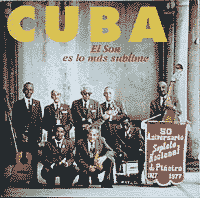
CUBA: EL SON ES LO MAS SUBLIME (A.S.P.I.C. X 55513)
This Swiss compilation came out in 1992 and it is still the best introduction to the Son music of Cuba. It features many of the great artists in crystal clear recordings and will send you off in pursuit of their individual albums. While the music was big in the 1920s (it is roughly contemporary with ragtime in the USA) some of the exponents lived long lives and were able to record their compositions (after perfecting them for years) in the Egrem Studios in Havana. By now, you have heard these songs performed by Buena Vista Social Club and its many offshoots but, believe me, those performances don't hold a candle to the originals heard here. From the exquisite balance of "Chan chan," performed by Compay Segundo, with bongo in one channel, muted trumpet in another, and the guitar, sounding almost hoarse -- if that can be said of a guitar -- picking a delicate lead before the metallic scraper comes back in, it's achingly beautiful. Compay, real name Faustino Repilado, was part of the Duo Los Compadres and also did a stint with the Matamoros group. Ignacio Piñeiro's big bomber, "Suavecito," is up next and sideswipes you before you can get a breath. The title of the album comes from the lyrics of this song performed in the original by the great Septeto Nacional (founded in 1927, still going strong). Carlos Embales and Abelardo Barroso are among the singers who started out with this group. Maria Teresa Vera fronts Trio Matamoros for Miguel Matamoros's ballad, "Lagrimas negras." It's hit after hit. A couple of Changuis from Guantanamo are thrown in for variety and to show the mutation of complex rhythms in guitar, tres and percussion. Another of the top ten all-time great Cuban songs is up next, "Echale salsita," again in the original from Ignacio Piñeiro. It winds itself up, almost like clockwork to the tres solo and everyone else, the bass, bongo, guiro and clave get drawn into the thrum of the strings. At 3 minutes in, time stands still, only the clave is locked in and everything just hangs in the air like a bird: it's one of the most phenomenal moments in recorded music. By the way, the same cover photo is used on a Septeto Nacional CD so you might buy that in error, but not to worry, that disc, Clasicos del Son includes many more of their hits, from "Las Cuatro Palomas" to "Ruñidera" to "La Cumbancha" with Agustin Lara. Compay Segundo graces us again with his raspy time-worn voice for "El Cuarto de tula" which also romps and rollicks along wildly, gaining momentum. The line-up is always the same, a simple small group of acoustic instruments: guitar or tres, or both, acoustic bass, trumpet and bongo, with the singers also playing claves and guiro or maracas. Throughout the album, the tres floats serenely over a very sportive bongo. We're not even halfway through and get banjaxed by the truly sublime, "Cómo está Miguel," from Septeto Típico Habanero, this time featuring Felix Chappottin on trumpet. El Guayabero is only represented with one track, but it's a doozie: "Como baila Marieta." Characterized as a "picturesque minstrel" on his collected hits El tren de la vida (Euro Tropical EUCD-15), Faustino Oramas -- "El Guayabero" -- was massively popular in the late 20s with songs like this one, "How Marietta dances." More raspy vocals with muted trumpet signal the big guns: Miguel Matamoros, this time with Cuarteto Maisi, performing a bolero-son, "Veneración." Sweetness and melancholy in equal amounts ooze from these fifty year old recordings that have been beautifully remastered and are as fresh as ever.
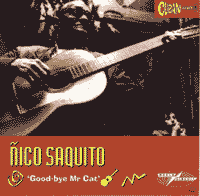
NICO SAQUITO
GOOD-BYE MR CAT (World Circuit WCD035)
Now that we have detente with Cuba -- finally -- there's a race on to get to Santiago and visit the Casa de la Trova before it posts a sign in English saying "We proudly serve Starbucks." While the compilation El Son es lo más sublime featured some stellar performances by Son groups from Cuba, it by no means exhausted the field, or covered all the luminaries. There are many wonderful compilations of Sextetos and Septetos on the market (e.g., single disc comps on Musica Latina Nostalgia from Belgium and Harlequin from England, a double disc set from Arhoolie, and a 3-CD set from the Goldies label), but there are also the individual singer-songwriters, who come from the long tradition of troubadours that stretched back to before the printed word in Europe. These men told universal truths with humor and insight into society. They generally backed themselves on a simple stringed instrument. I first encountered Nico Saquito on a compilation, where his song "Maria Cristina" shone out and I thought, sadly, since this gem was from a long time ago the singer was but a fading memory. But then in 1993 World Circuit discovered that he had emerged at the age of 80, in 1982 for a farewell show in Santiago. He performed some of his most beloved songs with El Duo Cubano and El Quarteto Patria (from which the remarkable Eliades Ochoa emerged). The set opens with his biggest hit, "Al Vaivén de mi carreta (The Rocking of my cart)," a guajira that was covered as far away as Senegal. They tear through "Maria Cristina" and give a heart-rending performance of "A Orillas del Cauto (On the banks of the Cauto)," from 1938. Ochoa throws some echo on his lead guitar solo, but Nico doesn't need any embellishment. His lyrics are given in translation in full in the carefully annotated booklet. The liner notes translate the beautiful guarachas and guajiras as well as the amusing banter between songs. The gentle call and response lyrics have a strong social message as well as demonstrating the humanity and warmth of a great poet. If this is too short for you (38 minutes), check out his hits from the late forties on La Bodeguita del Medio recorded with the Conjunto Oriental de Bimbi (Egrem CD-068). There's a copy of the vinyl on Amazon for $142.50, but hold on, the CD will turn up. Carlos Embale sings here, on some of Nico's 300 compositions. You can also hear "A Mi me gusta el cha-cha-cha" and many of the songs on Good-bye Mr Cat in their original versions.
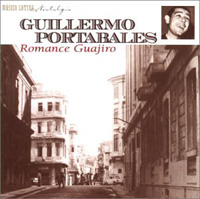
GUILLERMO PORTABALES
ROMANCE GUAJIRO (Musica Latina Nostalgia MLN55009 or Tumbao TCD-084)
While I am on the topic of great trovadors we cannot omit Guillermo Portabales, who rose to fame with some immortal tunes in the Cuban repertoire. He does not have a coarse voice, on the contrary, and his fine singing is backed by an unusually light and sprightly guitar. You could say his sound is more Spanish and less African than some of his contemporaries. The son was one rural style from Eastern Cuba when it was brought to the cities in the 1930s. Gradually trumpet was introduced and the music shifted more to a jazz mode and eventually led to full-fledged big band music. But in its early incarnations, Cuban rural music had many forms such as rumba and guaracha, and Portabales excelled at the guajira, which is featured on these early recordings. There are two versions of this album, from different labels, but containing the same songs from 1937 to 1943 in different order. He sings solo with his guitar, then with a trio and finally with a conjunto including bongo and claves driving the rhythm. There's superb interplay on the acoustic guitars from the Trio Habana, who also add sweet harmonies to the vocal (Check out "Habanera ven"). His version of "Al Vaivén de mi carreta (The Rocking of my cart)" has a slight edge over Nico Saquito's because of his whistling! (And check out his bird calls on "Flor de amor.") If you like this, and it is quite irresistible, then I suggest you check out his 15 Grandes Exitos also.
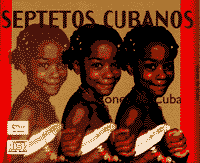
SEPTETOS CUBANOS
SONES DE CUBA (Musica Tradicional, Mexico 1990; distributed by Rounder)
Right now the musical ecology of Cuba is very fragile. The youngsters are eager to get into the first world and are listening more to Miami urban radio than their own heritage. Though the young jazz musicians are still classically trained, the indigenous forms are being neglected. Cuban son is not moribund but there has not been much innovation in it for many years. Of course there is room for improvisation in each song, but there are certain structural formalities, so fans of the genre want to hear the familiar songs cleanly and well executed. The devotees do not want new ideas, they want great acoustics, to be able to get inside the sound. The son traditionally begins with a largo section which establishes the theme, then the montuno kicks in. In this part the guitarist solos while the percussion builds over a repeating chorus. Some of the greatest exponents are bands that refresh their ranks as older members pass away, but hand on the tricks of the trade to preserve continuity. Cuarteto Patria, Septeto Nacional, Estudiantina Invasora and Septeto Tipico Oriental are all examples of this tradition, and all are found in this superb 2-CD set published in Mexico. In addition there are less well-known bands rounding out the set. The classics, "Echale salsita," "Son de la loma," "Chan chan," are here along with a lot of wonderful other tunes.
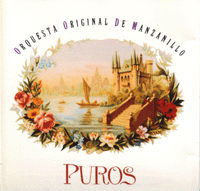
ORQUESTA ORIGINAL DE MANZANILLO
PUROS (Qbadisc 9003, 1992)
Updated versions of the Son, the rumba, the merengue, and other Cuban folk dances can be found on the scintillating PUROS by Orquesta Original de Manzanillo. A dozen tracks from the lush, romantic danzóns, awash with violins, to the stripped down rumbas with claves and scrapers are very catchy and even have familiar quotes. It may remind you of the music your parents listened to in the 'fifties and, though everyone fears growing up to become their parents, the continuity is reassuring and so is the feeling of pseudo-sophistication as you spill your martini trying to rumba.
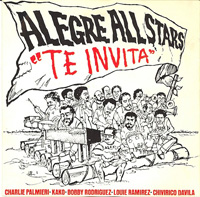
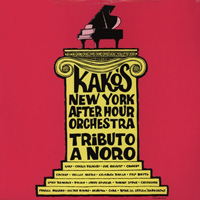
ALEGRE ALL STARS
TE INVITA (Charly 306)
Alegre was a small New York salsa label, formed by Al Santiago in 1955, rival to Tico (established in the 40s), Fania (founded 1963) and other heavies. In addition to Charlie Palmieri, Ricardo Ray and Johnny Pacheco albums, he issued the phenomenal Angel Canales as well as Eddie Palmieri's La Perfecta LP. In 1961, he came up with an idea to promote his label: put all his artists together and let them rip. So, under the leadership of pianist Charlie Palmieri he assembled his four main hornmen, half-a-dozen percussionists and his singers and gave them sketchy "head" arrangements: intros and outros, and rolled the tape. Okay, when was the last time you read album credits and there was a bartender listed? The booze-getter is billed above the "Also sax," another strange job description, unless it's a typo for "Alto." You know they are having too mucho fun because the tape continues to roll between numbers and we get to hear studio banter of a high calibre. "Where the hell's Kako?" It's inaudible at times, but you'll be asking yourself Whiskey Tango Foxtrot?!! In fact on Volume 3, Cecilio Carmona is credited with "Studio chatter." How many volumes were there? Well, five or six is the official count, between bouts of Liquid Nutrition. The Charly issue is a "Best of" compilation put out in London in 1992, but you can find the originals from the mid-60s on CD or vinyl here and there. Like the Tico label, Alegre was a salsa pioneer which was ultimately absorbed by Fania. And some of their artists also migrated to the better-known label, such as singer Cheo Feliciano, trumpeter Puchi Boulong, tromboner Barry Rogers and Palmieri the leader. From volume two the title cut, a tough arrangement of "El Manicero," is included. From volume three we hear "Yumbambe" and "Sono sono," and from volume four, "Manteca" by Chano Pozo & Dizzy (featuring Orlando Marin on timbales, since, apaprently, Kako hadn't shown up yet) and "Se acabo lo que se daba," with Juanchu on vocals. The longest track, "Bobby, bajo y clarinete" gives everyone room to solo, sometimes simultaneously as they overlap. I don't hear any clarinet, but it is incredibly textured. Four tracks are taken from their 1977 effort Perdido, including the opener "Alegre te invita," and the Duke Ellington/Juan Tizol classic featuring Louie Ramirez on vibes. This set closes with "Estoy buscando a Kako," a quest for the co-leader of the group, Kako on timbales, from their first 1961 session. They then seek out other performers by name, including Johnny (Pacheco) who plays wooden flute, Bobby (on bass), Chombo (sax), Barry (trombone) and so on round the room till Kako rips it up on his timbales. Speaking of Kako, if you like this intensity there's another great album, with most of the same personnel, also on the Alegre label, called Kako's New York After Hour Orchestra Tribute to Noro Morales. There are three pianists, Charlie Palmieri, Rene "El Latigo" Hernandez, and Hector Rivera, Cachao on bass, Chombo Silva on tenor, Joe Quijano on bongoes, three trumpets and two singers: Felo Brito and Chivirico Davila. I'd say it's also essential.

GRUPO FOLKLORICO Y EXPERIMENTAL NUEVAYORQUINO
CONCEPTS IN UNITY (Salsoul 20-60012)
Just as there are many kinds of Latin music, there's more than one kind of descarga in the world. There are the big band jam sessions with carefully orchestrated sheens of trumpet and trombone but there are also throw-downs that feature mainly the drummers. If you ever go to a flea market you've probably encountered free-form jams with mostly conga players rapping in the sunshine, occasionally spurred on by a cowbell or an agogo, while spectators clap or tap beer bottles in harmonic appreciation. In percussion-heavy jams the other instruments stand out more (they have to) and usually only solo once a groove has been laid down by the conga and bata players, bongoceros and others. This album came out on 2 LPs in 1975 and went out of print. It was remastered and reissued in 1994 and remains one of the best hard-driving Latin jam sessions ever waxed. The group, appropriately, jammed in public, most were young New Yorkers of Puerto Rican heritage. Some were Cubans. Their common heritage was the salsa of their parents, tunes like "Anabacoa" or "Cuba Linda." It's loose yet intense and the musicians are all reacting to one another: there are elements of the Cuban guajira, guaguanco and mambo as well as the plena of Puerto Rica, even hints of Polish mazurka. There are thundering solos on timbales. Trombone, piano and tres (Nelson Gonzalez who also plays guitar here) can also be heard in the mix. The legendary Chocolate Armenteros shows up to play one of his tunes on trumpet. For two tracks a harmonica player is featured, merging African and European traditions. By the second part we discover the spiritual aspect of the music, Santeria hymns to the Orishas from the Yoruba tradition, and here the drummers are led by Milton Cardona while the chorus invokes Babaluaye and Chango. Sadly, this is out of print once again, but I suspect demand will see it return to listeners.
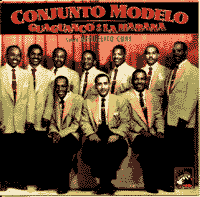
CONJUNTO MODELO
GUAGUANCÓ EN LA HABANA (TUMBAO TCD059)
The history of Cuban music pivots around one man: Arsenio Rodriguez, the blind tres player. Arsenio pushed up the percussion, added a piano, and tripled the trumpets of the traditional septet line-up, and pretty much singlehandedly invented salsa as we know it today. He was a prolific composer and surrounded himself with the cream of Havana's musicians in the late forties. By the early fifties he was in New York, consulting eye specialists, and soon made his home in the US, leaving behind the remnants of a great working band. In 1953, Lázaro Prieto, Arsenio's bassist, returned from New York to find the band, despite their obvious talents, were not thriving, so he took over management. For two years they gigged regularly at the Prado y Nocturno ballroom, sharing the bill with La Orchesta América and Beny Moré, while every afternoon at 4:30 pm they could be heard live on Radio Mambí. They made a few recordings, often fronted by vocalist Miguelito Cuní, which have been gathered together for this outstanding release in Tumbao's series of classic Cuban music. Cuní excels on the bolero "Te han mentido," and Felix Ferrer's "Con maña se rompe." The tres is to the fore on "No hay amor sin caridad," written by Raymond Cisneros who had to fill Arsenio's shoes in the band. He rises to the occasion. Regular vocalist Pedro Sarracent can be heard on the succint and blasting "Chenchere Comay." Though pianist Lili Martinez is not on these recordings, three of his great compositions are. This is suave and sophisticated music, mostly son montunos, and the clear recordings bring out the strong bass and the wonderful percussion work of "Chocolate" Alfonso on tumbadora and "Papa Kila" Suárez on bongos.

SIERRA MAESTRA
¡DUNDUNBANZA! (World Circuit 041 1994)
Known in America as "the Bo Diddley beat," that irresistible loping groove is the underpinning rhythm of Cuban son, propelled by two hardwood sticks knocked together. From its burgeoning popularity in the 1930s, through its peak in the 1940s, son slowly faded into musical history in Cuba, but it was always more than a codicil. In the 1980s a group of youngsters from Oriente, the Easternmost province of Cuba (home of Fidel), called Sierra Maestra, restored the power to this swinging, intense sound with a flawless compilation of unforgettable melodies recorded in London. The nine-piece band is centred around the tres (the Cuban guitar with three pairs of strings), played by Juan de Marcos Gonzalez, and the trumpet of Jesus Alemany, two talented musicians who later went on to greater fame as leaders respectively of Afro-Cuban All Stars and Cubanismo. The beautiful lead voices (the coro) and heavy percussion make this set sublime as it grinds down to the spiritual of pure Afro-Cuban chant. Sierra Maestro romp through son standards by Arsenio Rodriguez, and restored his music to its primacy in the Cuban canon.
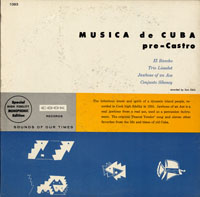
JAWBONE OF AN ASS
MUSICA DE CUBA PRE-CASTRO (Smithsonian Folkways; orig: Cook Records 01083)
I am late in getting around to reviewing this one. In fact the CD, like the original LP, has gone out of print, but it is available from Smithsonian Folkways as a download or custom CD. As you know Cook Records was a pioneer in High-Fidelity field recording in the early fifties. Now we look back on that era it does seem Hi-Fi was a pinnacle in sound reproduction and we seem to have gone the other way, via earbuds & downsampled files, to very low standards of musical fidelity. This set was assembled by Sam Eskin who went to Cuba in the pre-Revolution days and recorded typical trios and conjuntos. It's hard to tell whether he recorded these surreptitiously or with consent of the artists because some tracks have no titles, suggesting he was just hanging out with his Nagra over his shoulder or under his pineapple shirt. So there's a different feeling to the well-known songs of Trio Matamoros and others who went into the studio and cut 78s. When El Rancho Night Club Band kick things off, there's the palpable steaminess of a night club atmosphere, showgirls and rum ebbing and flowing. Then we are in the wooded hills of Oriente with Trio Lissabet giving us the familiar "Lagrimas Negras," in a spirited rendition with crisp much-practiced guitar. The third track is a street recording of Ritmo y Frutas de Cuba with the buzzing title instrument being rattled (in the outro) and some ragtag horns backing an accomplished flautist for a guaguanco rave-up. The Conjunto Siboney Band (clearly a tourist outfit), in their sole entry, turn in "El Manicero," and it's great: whacked percussion and a Chinese cornet make this a truly original rendition. As a musical snapshot this is a fine set; as a slice of Cuban music it is a delight.
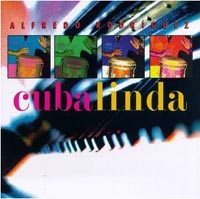
ALFREDO RODRIGUEZ
CUBA LINDA (Hannibal HNCD1339)
This is one of my favourite Cuban discs, but came out before I started this website, so has not been covered before, but it's time. (Besides I just noticed there are copies for sale on amazon for $1!) Alfredo Rodriguez starred with Cubanismo, in fact he was the elder statesman of that group of young turks who attempted to sweep away the Buena Vista juggernaut and show that there was more to Cuban music than some old boleros with slide guitar. Cubanismo was the brainchild of Jesús Alemañy who had started out with Juan de Marcos González in orquesta Sierra Maestra: the latter was the guiding force behind many of the Buena Vista projects, including Afro Cuban All Stars. Alfredo made this album in 1996 hot off the road with Cubanismo, and brought many of the luminaries of that team along for this brilliant session, recorded at the state-owned Egrem studios in Havana and Santiago. Tata Güines is here, and so are Jesús and Luis Alemañy on trumpets. The repertoire is mostly traditional, but Rodriguez' light touch polishes up every cadenza to make it shine. The title song starts as a ballad (by Virgilio Marti) but evolves into a purely percussive romp in the solar with rootsy rumba quinto, chekere, claves, etc, featuring among others Los Terry. The vocals by "El Goyo" lead to a fiery guaguancó by the junior Alemañy on trumpet and a dextrous burst on the ivories by Alfredo. Strings and flute from Orquesta Aragon show up for the old 1934 cornball "Cuando vuelvo a tu lado (What a difference a day makes)," a classic danzon-cha by Maria Grever, Mexico's first successful woman composer. Roots is to the fore on "Tumba mi tumba" -- a French piece(!) -- I did not know the story behind this. When Toussaint L'Ouverture started the Revolution in Haiti, French planters moved to Cuba (with their slaves) and this music is still kept alive by two societies of the French tumba. "Mercedita yà me voy" sounds like a Yoruban chant to Oba, but is an original piece by Rodriguez. It's the one I always played on the air when the CD came out. Again the Aragon string section steps up. Treat yourself to some class.
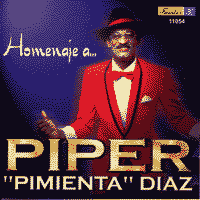
PIPER DIAZ WITH THE LATIN BROTHERS AND FRUKO Y SUS TESOS
HOMENAJE A PIPER 'PIMIENTA' DIAZ (DISCOS FUENTES 11054)
HOMENAJE A PIPER 'PIMIENTA' DIAZ is on my top ten list of all-time great Latin albums. My good buddy Deejay I.J. turned me onto the Latin Brothers and this is a great introduction if you don't know their work. On this compilation, two groups fronted by Piper Diaz are featured: the Latin Brothers and Fruko y Sus Tesos. The outstanding cuts are by the Latin Brothers but the whole thing is a bomb of the kind you recall from groups like Palmieri's La Perfecta of the mid-seventies: everyone is grooving, excitement sparks off the cowbell, the rhythm sucks you into its vortex. It's more rum than coke. Atop some phat bass licks are gnarlier horn-lines than at a rhinoceros' love-in. It's salsa with a cumbia feel. Piper was a huge star in his native Cali from the inception of Discos Fuentes in 1971 (His debut recording of "Oriza" with Fruko is included here). He became THE voice of Colombian salsa. In 1974 he moved to front the Latin Brothers. The album kicks off with his signature song, recorded with the Latin Brothers in 1976, "Las Caleñas son como las flores," a simple love song about the sexy women of Cali. "Buscandote" from 1975 follows, and it has a monster piano solo as well as a rave-up outro. The tempo doesn't slow for a moment, and in fact goes through the roof on "Duelo de picoteros," a ten minute jam (with a deceptive lounge piano intro) in which Piper trades vocals with John Jairo. This is my favourite track on the album and ends with the group poking fun at themselves as they speed up and then suddenly in the last few bars the engineer ups the tempo of the playback on the backing vocals making it sound like the Chipmunks! This CD steams along relentlessly; the style doesn't change noticeably from group to group, and the key element of Piper's vocal pipes is always prominent.
After a long illness (evident in the cover photo), Piper died in June 1998, but this album remains to remind us, or introduce us, to a giant of Latin music.
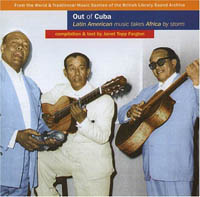
OUT OF CUBA
(LATIN AMERICAN MUSIC TAKES AFRICA BY STORM) (Topic Records TSCD927)
Another collection of oldies, this time with a unique approach. Call me a moldy fig, if you must, but this is a great album. It was compiled by Janet Topp Fargion of the British Library Sound Archive, and provides a wonderful spectrum of the range of His Master's Voice GV series from the early 1928 Trio Matamoros' son recordings to the sambas and guajiras of the 1950s. Much has been made about the influence of the GV series of 78s on African popular music and the African imagination. Countless albums mention the importance of Trio Matamoros' recording of "El Manisero" (GV3); I even did a two-hour radio special tracing the influence of this song on African pop music. HMV released a couple of hundred GV records with the distinctive magenta labels. The initials stood for Gramophone and Victor which were the two catalogues mined by HMV for these releases. The series started in 1933 at the height of the depression and HMV was inspired by the runaway success of Moises Simon's "El Manicero" to start promoting Latin music in other markets. The reason the 78 was so successful in Africa was that the playing apparatus would stand alone and didn't require electricity. Plus the shellac discs could hold up in the heat and humidity. You can hear how Rico's "Lamento Esclavo" would strike a chord with its lyrics about Congo libre. Written in 1932 by Eliseo Grenet, it says, "Black I am, and black is my luck. Poor me! I am Lucumi, a slave. I can't live in captivity but let's dance, Panch my black beauty, for one day the Congos will be free." Rico's Creole Band also turns in a song in French Creole, "Mon aime, doudou moin," complete with sprightly clarinet, which sounds Martiniquan. I learn from CUBANS IN PARIS 1930-38 that flute-, sax- and clarinet-player Rico took over a band from a Martiniquan drummer at La Coupole. The band had Cuban and Antillean members and was occasionally joined by Moises Simon for recording, as well as a Brasilian, Linda da Costa. From the Congo to the conga, we get a romping rendition of "Alegra Conga" from Hermanos Castro with Eddy Urquia on vocals. Machin turns in another Moises Simon song, "Cachumbambé" which demonstrates the talent of this composer in a love song. The CD gets stronger as it goes on. Puerto Rico's Canario turns in a great bolero-son "Alla va," recorded in New York in 1933. This is followed by a plena rife with double entendre called "Menealo que se empelota (Stir it up or she'll get annoyed)," probably also the work of Canario and songwriter Rafael Hernandez, using the pseudonym Orquesta Victor Antillana. Xavier Cugat takes a hymn to Chango and turns it into a Looney Tunes soundtrack. You can almost see the cartoon cannibals dancing around the cauldron of boiling missionaries during his silly nonsensical "rap." By 1952 the GV series included the new expanded sound of the 8-piece conjunto. As demonstration we get the best of the best: Arsenio Rodriguez doing "Dundumbanza." The recording is not great but Lili Martinez's piano solo is breathtaking, and Chocolate Armenteros goes off on trumpet throughout. (Interestingly, Fargion says this was recorded in New York on 9 September 1952, but according to the Tumbao CD [DUNDUNBANZA 1946-51 TCD-043], it was recorded in Cuba on 12 January 1949. I think Tumbao is right: I don't believe the band went with him to New York.) This is a tough act to follow. Trio Yara is new to me and they provide a smoking conga callejera or street conga: "Babae" with the unforgettable chorus, "Zum, zum, zum baba-eh." To show the variety of stuff that Cuban bands would play on the dancefloor we return to Rico and his Creoles for a samba and, to close, a genuine Brasilian, Luis Gonzaga, ties the ribbon into a bow with a love song played on accordion.
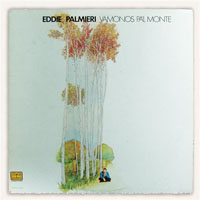
EDDIE PALMIERI
VAMONOS PA'L MONTE (FANIA 773 130 007-2) 62 mins
The more talented of the Palmieri brothers, Eddie had already made a mark with his band La Perfecta (STRAIGHT AHEAD [TICO 1964] is a must-hear) when he decide to switch it up and use other sidemen. His new approach led to a series of albums, the third of which is "Vamonos pa'l monte," and includes the scorching title of that name. He moved closer to jazz in this period (being influenced by Monk and McCoy Tyner, at that time peaking with the Coltrane quartet) and adds a political twist to the lyrics. His new sound included trap drums because he thought the rat-a-tat of the snare drum was more martial, and also he scored harmonic rhythms for the horn section. This song became the defining anthem of the era and is still played and requested by Latin deejays. He even invited his older brother Charlie to play organ on the song which says, "Things are so messed up, let's just go back to the mountains." Charlie is steaming: he has a lot to prove. His organ montuno reminds me of blues. About two minutes into Charlie's solo they hit the big-room reverb & the whole vista opens up into a swirling ballroom on the mountain peak. But the album also has solid links to the past with the presence of Alfredo "Chocolate" Armenteros on trumpet and the inclusion of "Viejo Socarron" by Lili Martinez Griñan who played with Arsenio in the 40s, and also the bolero "Yo no se," composed by Jacinto Scull, and first recorded by Sonora Matancera in the 50s. While paying tribute to his roots, Palmieri pulls them up and strides boldly in a new direction.

RAY BARRETTO
ACID (FANIA 773 130 022-2) 35 mins
Jazz and funk hit Latin on this set. Barretto drives from the back seat on congas. A Puerto Rican kid from New York he became "black" as a GI in Germany in the late 40s when fellow soldiers turned him on to jazz. He discovered Chano Pozo and took up congas and then formed a traditional Cuban charanga back in the Big Apple. But in 1966 when boogaloo hit, he decided to take a chance and get away from the flute and violins to a more jazz-based sound. He's got Bobby "Big Daddy" Rodríguez on Ampeg baby bass, and the great Orestes Vilato on timbales. He brought Orestes along from his previous group but for the first time features him as a soloist which had a huge impact on all Latin music. Trumpeter Rene Lopez has absorbed Miles and Dizzy; Louis Cruz on teclas is cruisin! They switch effortlessly to English for "Mercy Mercy Baby" and "A Deeper shade of soul," throwing in Memphis-style horns for a change of mood. The title track, "Acid," which was done as a first take, is pure magic: everyone shines brilliantly. The bass is locked into a simple pattern and each musician steps up to take a swing at the groove. "A Deeper shade of Soul" quotes Sam and Dave, "Soul man," and a bunch of other familiar riffs. It's not the "heavy, man" squinting Jerry-Garcia acid they are dropping but the "Sock it to me!," "Freak out, baby" acid from acid-washed jeans on groovy chicks. But then they get rootical on the last cut, "Espiritu libre," with jawbone percussion and way-out trumpet. Barretto & Vilato have a dialogue in the West African bembe rhythm while the rest of the guys go nutty & take you on another kind of trip, back to the beginnings of rhythmic consciousness. The cowbell clanks relentlessly and wordless sounds are uttered, but it all coheres.

MARKOLINO DIMOND
BRUJERIA (Fania 773 130 123-2)
What's it called when you buy an album you already have over again. No, not Alzheimer's. I mean when you buy a new CD that has been remastered when you already have the old CD. Folly? Well I did and have been playing this new version (8% sonically clearer than the old one) endlessly. In fact I scratched the damn thing after about 20 listens (surely wax cylinders lasted longer than that?!!), and so I got out the old one, but it didn't seem as dynamic, so I borrowed IJ's copy and burned it. And yes, he too also had the earlier version! There are several factors at work here. It's the holiday season when you buy gifts for others you indulge yourself in a few things you want that you know no one would buy you. Next, FANIA is reissuing a lot of its classic material so I have been enjoying some of the Hector Lavoe, Johnny Pacheco, etc I missed the first time around. Then there is the fact that this album was last released under a different title by a different artist (the singer) with no liner notes. So now FANIA has reissued it (in a limited edition of 5010 numbered copies), cleaned it up so the bass is a bit bigger and the sound about 8% crisper (sounds like Lay's potato chips) and now with a replica of the original cover so we get to see Markolino looking muy stoned, and the back cover which tells us who is on it. The amazing thing is even the Descarga database didn't know anything about it and said only "classic New York salsa of the 60s and 70s!" I asked a few New York music pals and they came up with a couple of tentative names. But now we know who's on here & that it was recorded in 1971. And when you listen to it you can hear Markolino say "Vaya Andy!" at the start of the bass solo on "Tiene Sabor," so that can only be Andy Gonzalez.
Markolino was a genius pianist with a deft, Vorticist attack. He leaves lots of space and makes jagged moves as he essays different views, often simultaneously, where he's not sure his hands can keep up with his brain. It's intuitive and percussive but requires control to get out of the death-spirals it sends you into. He appeared on a few sessions with Willie Colon (The Hustler and Guisando, both Fania), Ismael Quintana (Vaya 1974), Frankie Dante Beethoven's V (Cotique 1975), Hector Lavoe's La Voz (Fania 1975), and Andy Harlow's Latin Fever (Vaya 1976) before dropping out of the scene and dying of a heroin overdose in 1988. But this is his testament. In the cover photo by Bob Gruen he looks like Hendrix, and you can tell he was one of those blazing comets that populate the musical stratosphere. The Icarus syndrome is common in all art but junk cuts a wide swath through music as the Gods call home those who are just too heavy for earth's gravity.
Larry Harlow and Johnny Pacheco produced this album, and there you have the key to FANIA's quality. They knew the good stuff and that's what made it onto their labels. As for the band "His Savor," I would have to say they are unknowns: Richie Montanez, first trombone, Fudgy Torres, second trombone, Danny Reyes, trumpet, Louie Rivera, bongo and Antonio Tapia, conga. The two bassists are well-known: Andy Gonzalez and also Eddie "Gua Gua" Rivera. The lead vocals are by Angel Canales, and the coro features two other fine singers, Ismael Quintana and Justo Betancourt. Angel Canales made his debut on this album. When Markolino dropped out it was reissued as TIENE SABOR under Canales' name. Some of the band continued with him and they replaced Markolino with a woman pianist, Lesette Wilson. But his career was also short. He moved to Miami and became a diamond cutter about 1982 when "salsa romantica" took hold.
The album has seven compositions, all by Dimond. They are relatively short but establish a mood where there's room for solos and a sense that no one is pressed. It's a classic salsa conjunto, along the Eddie Palmieri model, with two trombones and expansive arrangements. After an opening statement they drop back to bass and piano with congas and cowbell pushing things forward as the three singers do a call-and-response. The album opens with the title cut ("I believe in witch-craft"). After a brief piano solo the trumpet solos over the coro, then the two bones come back and it builds to a rocking mid-section. The last verse invokes the "Siete Potencias Africanas," Lazaro, and a few other religious icons before tying it up nicely.
Then we go "down town," with the vamp from "(They say the lights are always bright on) Broadway" as opener for "Mi Irmita." Markolino quotes King Cole's "Mona Lisa," and hesitates delicately before going into a rapid burst of G minor 7 to C7 to and fro (I recognize it because it's the main chords of "Tea for two": you can rock the left hand between G and F). Now the trombones get to solo y ahora somos cocinando con gaz! All this in five and a half minutes!
"Aguardiente," a paean to booze, is one of the great mood-setters of the disc. Starting out with thunder on the horns and a bit of echo on the coro. Montanez gets to sound off early and packs a punch in his first eight-bar solo. Dimond launches into some block chords then his solo quotes "Three blind mice" -- very tastefully too! But it's an Afro-Cuban jazz version. If you think about jazz at the time I guess people like McCoy Tyner were in the ascendancy. In Cuban music, or at least salsa, it was the Palmieri brothers all the way. Dimond is on a whole other level as a pianist and band-leader. He gives everyone room. He tries stuff on and if it doesn't work, tosses it aside, and thinks for a few bars before attacking it again. Consequently you hear the same gambits in several of his solos. This is very instructive.
"Tiene sabor," the name of the conjunto and also the title of the album when it was reissued as a Canales project, seems less coherent than the other numbers, as if no one is sure of the melody at first. But Markolino does his "Tea for two" vamp and changes it up. Then the horns come back with confidence and the cowbell helps them build a base for a fierce trombone attack. Midway through it breaks down to Andy Gonzalez with maracas, congas and bongo. There's also timbales (uncredited). These coasting moments are bliss.
"Side B" begins with my desert-island disc "Mariquita," the heart of the album and the longest track at 7 minutes. It sounds a bit like the Latin Brothers, my favourite Colombian salsa band. It romps along, but still seems laid back, and then when you think it is ending, the coro stick their teeth into the refrain "Ven Ma-ri-qui-ta!" (five beats, like a clave) there's a blasting trumpet solo and everyone else is inspired to take another shot at the riff. This must have been smoking live, I could listen to hours of it. The ballad "Yo no tenga pena" seems anguished. The singer is confident and the horns pour it on, but everyone stops to hear "El Diamante" for a moment and gets juiced. This is why you buy a remastered disc: You are almost in the studio (Well, if you put you ear up to the speaker or crank it up). During this solo Canales calls out something about the streets of Puerto Rico, maybe he's talking about Dimond. At this point the band comes back in full effect and you realize you've turned it up WAY TOO LOUD!!! OK, screw the neighbours. This is one of those bathtub-electroshock-orgasmo moments. We have to go out in style, after all this is an album for the ages, one of the great musical statements of an era. "El Barrio" is another stomping-hot groove. (Actually I think there's a pop on the record they took this from, or a glitch in the tape). Dimond pours out cadences just to show he can play fast and coherently too. His right hand trills while he chords and bounces about with the left, thinks "Three blind mice," and stops himself ("I just did that") before going into a montuno-styled vamp as the cowbell brings back the whole band for a grand apotheosis. Wow, 40 minutes. Better start it over.